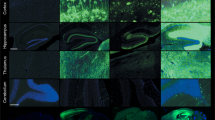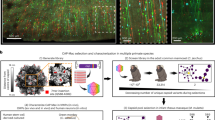Abstract
Adenovirus serotype 5 (Ad5) is widely used in the development of gene therapy protocols. However, current gene therapy strategies involving brain are mostly based on intra-cranial injection. A major obstacle for systemically administered vectors to infect brain tissue is the blood–brain barrier (BBB). One strategy to cross the BBB is transcytosis, a transcellular transport process that shuttles a molecule from one side of the cell to the other side. Recently, melanotransferrin (MTf)/P97 was found to be able to cross the BBB and accumulate in brain. We thus hypothesize that re-directing Ad5 vectors to the MTf transcytosis pathway may facilitate Ad5 vectors to cross the BBB. To test this hypothesis, we constructed a bi-specific adaptor protein containing the extracellular domain of the coxsackie-adenovirus receptor (CAR) and the full-length melanotransferrin (sCAR-MTf), and investigated its ability to re-direct Ad5 vectors to the MTf transcytosis pathway. We found this adaptor protein could re-direct Ad5 to the MTf transcytosis pathway in an in vitro BBB model, and the transcytosed Ad5 viral particles retained their native infectivity. The sCAR-MTf-mediated Ad5 transcytosis was temperature- and dose dependent. In addition, we examined the directionality of sCAR-MTf-mediated Ad5 transcytosis, and found the efficiency of apical-to-basal transcytosis was much higher than that of basal-to-apical direction, supporting a role of this strategy in transporting Ad5 vectors towards the brain. Taken together, our study demonstrated that re-directing Ad5 to the MTf transcytosis pathway could facilitate gene delivery across the BBB.
This is a preview of subscription content, access via your institution
Access options
Subscribe to this journal
Receive 12 print issues and online access
$259.00 per year
only $21.58 per issue
Buy this article
- Purchase on Springer Link
- Instant access to full article PDF
Prices may be subject to local taxes which are calculated during checkout





Similar content being viewed by others
References
Barzon L, Zanusso M, Colombo F, Palu G . Clinical trials of gene therapy, virotherapy, and immunotherapy for malignant gliomas. Cancer Gene Ther 2006; 13: 539–554.
Cabrera-Salazar MA, Novelli E, Barranger JA . Gene therapy for the lysosomal storage disorders. Curr Opin Mol Ther 2002; 4: 349–358.
Hsich G, Sena-Esteves M, Breakefield XO . Critical issues in gene therapy for neurologic disease. Hum Gene Ther 2002; 13: 579–604.
Minshall RD, Sessa WC, Stan RV, Anderson RG, Malik AB . Caveolin regulation of endothelial function. Am J Physiol Lung Cell Mol Physiol 2003; 285: L1179–L1183.
Minshall RD, Tiruppathi C, Vogel SM, Malik AB . Vesicle formation and trafficking in endothelial cells and regulation of endothelial barrier function. Histochem Cell Biol 2002; 117: 105–112.
Descamps L, Dehouck MP, Torpier G, Cecchelli R . Receptor-mediated transcytosis of transferrin through blood–brain barrier endothelial cells. Am J Physiol 1996; 270: H1149–H1158.
Friden PM, Walus LR, Musso GF, Taylor MA, Malfroy B, Starzyk RM . Anti-transferrin receptor antibody and antibody-drug conjugates cross the blood–brain barrier. Proc Natl Acad Sci USA 1991; 88: 4771–4775.
Carreno MP, Krieff C, Irinopoulou T, Kazatchkine MD, Belec L . Enhanced transcytosis of R5-tropic human immunodeficiency virus across tight monolayer of polarized human endometrial cells under pro-inflammatory conditions. Cytokine 2002; 20: 289–294.
Ouzilou L, Caliot E, Pelletier I, Prevost MC, Pringault E, Colbere-Garapin F . Poliovirus transcytosis through M-like cells. J Gen Virol 2002; 83: 2177–2182.
Di Pasquale G, Chiorini JA . AAV transcytosis through barrier epithelia and endothelium. Mol Ther 2006; 13: 506–516.
Demeule M, Poirier J, Jodoin J, Bertrand Y, Desrosiers RR, Dagenais C et al. High transcytosis of melanotransferrin (P97) across the blood–brain barrier. J Neurochem 2002; 83: 924–933.
Moroo I, Ujiie M, Walker BL, Tiong JW, Vitalis TZ, Karkan D et al. Identification of a novel route of iron transcytosis across the mammalian blood–brain barrier. Microcirculation 2003; 10: 457–462.
Rose TM, Plowman GD, Teplow DB, Dreyer WJ, Hellstrom KE, Brown JP . Primary structure of the human melanoma-associated antigen p97 (melanotransferrin) deduced from the mRNA sequence. Proc Natl Acad Sci USA 1986; 83: 1261–1265.
Wickham TJ, Mathias P, Cheresh DA, Nemerow GR . Integrins alpha v beta 3 and alpha v beta 5 promote adenovirus internalization but not virus attachment. Cell 1993; 73: 309–319.
Bergelson JM, Cunningham JA, Droguett G, Kurt-Jones EA, Krithivas A, Hong JS et al. Isolation of a common receptor for Coxsackie B viruses and adenoviruses 2 and 5. Science 1997; 275: 1320–1323.
Santis G, Legrand V, Hong SS, Davison E, Kirby I, Imler JL et al. Molecular determinants of adenovirus serotype 5 fibre binding to its cellular receptor CAR. J Gen Virol 1999; 80 (Part 6): 1519–1527.
Dmitriev I, Kashentseva E, Rogers BE, Krasnykh V, Curiel DT . Ectodomain of coxsackievirus and adenovirus receptor genetically fused to epidermal growth factor mediates adenovirus targeting to epidermal growth factor receptor-positive cells. J Virol 2000; 74: 6875–6884.
Zhu ZB, Makhija SK, Lu B, Wang M, Rivera AA, Preuss M et al. Transport across a polarized monolayer of Caco-2 cells by transferrin receptor-mediated adenovirus transcytosis. Virology 2004; 325: 116–128.
Everts M, Kim-Park SA, Preuss MA, Passineau MJ, Glasgow JN, Pereboev AV et al. Selective induction of tumor-associated antigens in murine pulmonary vasculature using double-targeted adenoviral vectors. Gene Therapy 2005; 12: 1042–1048.
Yang J, Tiong J, Kennard M, Jefferies WA . Deletion of the GPI pre-anchor sequence in human p97 – a general approach for generating the soluble form of GPI-linked proteins. Protein Expres Purif 2004; 34: 28–48.
Wong D, Dorovini-Zis K, Vincent SR . Cytokines, nitric oxide, and cGMP modulate the permeability of an in vitro model of the human blood–brain barrier. Exp Neurol 2004; 190: 446–455.
Boveri M, Berezowski V, Price A, Slupek S, Lenfant AM, Benaud C et al. Induction of blood–brain barrier properties in cultured brain capillary endothelial cells: comparison between primary glial cells and C6 cell line. Glia 2005; 51: 187–198.
Flecher NF, Brayden DJ, Brankin B, Worrall S, Callanan JJ . Growth and characterisation of a cell culture model of the feline blood–brain barrier. Vet Immunol Immunopathol 2006; 109: 233–244.
Honda M, Nakagawa S, Hayashi K, Kitagawa N, Tsutsumi K, Nagata I et al. Adrenomedullin improves the blood–brain barrier function through the expression of claudin-5. Cell Mol Neurobiol 2006; 26: 109–118.
Jeliazkova-Mecheva VV, Hymer WC, Nicholas NC, Bobilya DJ . Brief heat shock affects the permeability and thermotolerance of an in vitro blood–brain barrier model of porcine brain microvascular endothelial cells. Microvasc Res 2006; 71: 108–114.
Rubin LL, Hall DE, Porter S, Barbu K, Cannon C, Horner HC et al. A cell culture model of the blood–brain barrier. J Cell Biol 1991; 115: 1725–1735.
Dehouck B, Fenart L, Dehouck MP, Pierce A, Torpier G, Cecchelli R . A new function for the LDL receptor: transcytosis of LDL across the blood–brain barrier. J Cell Biol 1997; 138: 877–889.
Fillebeen C, Descamps L, Dehouck MP, Fenart L, Benaissa M, Spik G et al. Receptor-mediated transcytosis of lactoferrin through the blood–brain barrier. J Biol Chem 1999; 274: 7011–7017.
Ji B, Maeda J, Higuchi M, Inoue K, Akita H, Harashima H et al. Pharmacokinetics and brain uptake of lactoferrin in rats. Life Sci 2006; 78: 851–855.
Pan W, Kastin AJ, Zankel TC, van Kerkhof P, Terasaki T, Bu G . Efficient transfer of receptor-associated protein (RAP) across the blood–brain barrier. J Cell Sci 2004; 117: 5071–5078.
Leveugle B, Spik G, Perl DP, Bouras C, Fillit HM, Hof PR . The iron-binding protein lactotransferrin is present in pathologic lesions in a variety of neurodegenerative disorders: a comparative immunohistochemical analysis. Brain Res 1994; 650: 20–31.
Jefferies WA, Food MR, Gabathuler R, Rothenberger S, Yamada T, Yasuhara O et al. Reactive microglia specifically associated with amyloid plaques in Alzheimer's disease brain tissue express melanotransferrin. Brain Res 1996; 712: 122–126.
Rebeck GW, Harr SD, Strickland DK, Hyman BT . Multiple, diverse senile plaque-associated proteins are ligands of an apolipoprotein E receptor, the alpha 2-macroglobulin receptor/low-density-lipoprotein receptor-related protein. Ann Neurol 1995; 37: 211–217.
Yamada T, Tsujioka Y, Taguchi J, Takahashi M, Tsuboi Y, Moroo I et al. Melanotransferrin is produced by senile plaque-associated reactive microglia in Alzheimer's disease. Brain Res 1999; 845: 1–5.
Mikogami T, Heyman M, Spik G, Desjeux JF . Apical-to-basolateral transepithelial transport of human lactoferrin in the intestinal cell line HT-29cl.19A. Am J Physiol 1994; 267: G308–G315.
Bi BY, Liu JL, Legrand D, Roche AC, Capron M, Spik G et al. Internalization of human lactoferrin by the Jurkat human lymphoblastic T-cell line. Eur J Cell Biol 1996; 69: 288–296.
Richardson DR, Morgan EH . The transferrin homologue, melanotransferrin (p97), is rapidly catabolized by the liver of the rat and does not effectively donate iron to the brain. Biochim Biophys Acta 2004; 1690: 124–133.
Kanerva A, Mikheeva GV, Krasnykh V, Coolidge CJ, Lam JT, Mahasreshti PJ et al. Targeting adenovirus to the serotype 3 receptor increases gene transfer efficiency to ovarian cancer cells. Clin Cancer Res 2002; 8: 275–280.
Wu H, Seki T, Dmitriev I, Uil T, Kashentseva E, Han T et al. Double modification of adenovirus fiber with RGD and polylysine motifs improves coxsackievirus-adenovirus receptor-independent gene transfer efficiency. Hum Gene Ther 2002; 13: 1647–1653.
Belousova N, Korokhov N, Krendelshchikova V, Simonenko V, Mikheeva G, Triozzi PL et al. Genetically targeted adenovirus vector directed to CD40-expressing cells. J Virol 2003; 77: 11367–11377.
Koizumi N, Mizuguchi H, Utoguchi N, Watanabe Y, Hayakawa T . Generation of fiber-modified adenovirus vectors containing heterologous peptides in both the HI loop and C terminus of the fiber knob. J Gene Med 2003; 5: 267–276.
Belousova N, Krendelchtchikova V, Curiel DT, Krasnykh V . Modulation of adenovirus vector tropism via incorporation of polypeptide ligands into the fiber protein. J Virol 2002; 76: 8621–8631.
Liang Q, Dmitriev I, Kashentseva E, Curiel DT, Herschman HR . Noninvasive of adenovirus tumor retargeting in living subjects by a soluble adenovirus receptor-epidermal growth factor (sCAR-EGF) fusion protein. Mol Imag Biol 2004; 6: 385–394.
Izumi M, Kawakami Y, Glasgow JN, Belousova N, Everts M, Kim-Park S et al. In vivo analysis of a genetically modified adenoviral vector targeted to human CD40 using a novel transient transgenic model. J Gene Med 2005; 7: 1517–1525.
Pereboev AV, Nagle JM, Shakhmatov MA, Triozzi PL, Matthews QL, Kawakami Y et al. Enhanced gene transfer to mouse dendritic cells using adenoviral vectors coated with a novel adapter molecule. Mol Ther 2004; 9: 712–720.
Wu H, Dmitriev I, Kashentseva E, Seki T, Wang M, Curiel DT . Construction and characterization of adenovirus serotype 5 packaged by serotype 3 hexon. J Virol 2002; 76: 12775–12782.
Acknowledgements
We thank Dr Alexander Pereboev for his advice on protein purification, and Minghui Wang for his assistance in quantitative PCR analysis. This study was supported by NIH brain SPORE grant P50 CA097247 (GYG and HW), Juvenile Diabetes Research Foundation grant 1-2005-71 (HW), and Muscular Dystrophy Association grant MDA 3590 (DTC).
Author information
Authors and Affiliations
Corresponding author
Rights and permissions
About this article
Cite this article
Tang, Y., Han, T., Everts, M. et al. Directing adenovirus across the blood–brain barrier via melanotransferrin (P97) transcytosis pathway in an in vitro model. Gene Ther 14, 523–532 (2007). https://doi.org/10.1038/sj.gt.3302888
Received:
Revised:
Accepted:
Published:
Issue Date:
DOI: https://doi.org/10.1038/sj.gt.3302888
Keywords
This article is cited by
-
The phosphatase and tensin homolog gene inserted between NP and P gene of recombinant Newcastle disease virus oncolytic effect test to glioblastoma cell and xenograft mouse model
Virology Journal (2022)
-
Complex of human Melanotransferrin and SC57.32 Fab fragment reveals novel interdomain arrangement with ferric N-lobe and open C-lobe
Scientific Reports (2021)
-
Anti-cancer Antibody Trastuzumab-Melanotransferrin Conjugate (BT2111) for the Treatment of Metastatic HER2+ Breast Cancer Tumors in the Brain: an In-Vivo Study
Pharmaceutical Research (2016)
-
In vivo SELEX for Identification of Brain-penetrating Aptamers
Molecular Therapy - Nucleic Acids (2013)
-
Surface Characteristics of Nanoparticles Determine Their Intracellular Fate in and Processing by Human Blood–Brain Barrier Endothelial Cells In Vitro
Molecular Therapy (2011)



